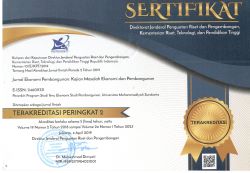Analysis of the Competitiveness of Indonesia Tourism Price Compared to the Competitors (Demand Elasticity Approach)
Rayinda Citra Utami(1), Djoni Hartono Hartono(2), Agni Alam Awirya(3*)(1) Kementerian Pariwisata
(2) Universitas Indonesia
(3) Bank Indonesia
(*) Corresponding Author
Abstract
This study applies Almost Ideal Demand System models to examine Indonesia’s competitiveness as a tourist destination compared to two main competitor countries. The model was used to estimate the sensitivity of tourism demand from seven tourist-main market countries to price changes, the tourists’ total budget and global economic crisis. The model estimated result meets the assumptions of the demand theory: homogeneity and symmetry. The elasticity price shows that Indonesia is more competitive than Thailand among Australian and American tourists; while Indonesia is more competitive than Malaysia among American tourists. The research result also shows that the tourism price is the main determinant affecting the allocation of tourist expenditure in the three destinations.
Keywords
Full Text:
PDFReferences
Blanke, J., & Chiesa, T. 2013.The travel & tourism competitiveness report 2013: reducing barriers to economic growth and job creation. Geneva, Switzerland: World Economic Forum.
Cortes-Jimenez, I., Durbarry, R., & Pulina, M. 2009. Estimation of outbound Italian tourism demand: a monthly dynamic EC-LAIDS model. Tourism Economics, 15(3), 547-565.
Crouch, G.I. 1996. Demand elasticities in international marketing: a meta-analytical application of tourism. Journal of Business Research, 36, 117-136.
Crouch, G.I. & Ritchie, J.R.B. 1999.Tourism, competitiveness, and societal prosperity.Journal of Business Research, 44, 137-152.
Darvas, Z. 2012. Real effective exchange rates for 178 countries: a new database. Bruegel Working Paper 2012/06.
http://www.bruegel.org
De Mello, M., Pack, A., & Sinclair, M. T. 2002.A system of equations model of UK tourism demand in neighbouring countries.Applied Economics, 34(4), 509-521.
Deaton, A. S., & Muellbauer, J. 1980.An almost ideal demand system.American Economic Review, 70(3), 312-326.
Deluna, R Jr., & N. Jeon. 2014. Determinants of International Tourism Demand for the Philippines: An Augmented Gravity Model Approach. Munich Personal RePEc Archive Paper No. 55294, posted 14. April 2014.
Divisekera, S. 2003.A model of demand for international tourism.Annals of Tourism Research, 30, 31-49.
Durbarry, R., & Sinclair, M.T. 2003. Market shares analysis: the case of French tourism demand. Annals of Tourism Research, 30(4), 927-941.
Dwyer, L., Forsyth, P., & Rao, P. 2000. The price competitiveness of travel and tourism: a comparison of 19 destinations. Tourism Management, 21(1), 9-22.
Euromonitor International (2012, August).Tourism flows inbound in Thailand. October 10, 2013.
http://portal.euromonitor.com
Euromonitor International (2013a, September).Tourism flows inbound in Indonesia. October 10, 2013.
http://portal.euromonitor.com
Euromonitor International (2013b, September).Tourism flows inbound in Malaysia. October 10, 2013.
http://portal.euromonitor.com
Forsyth, P., & Dwyer, L. 2009.Tourism price competitiveness.The travel & tourism competitiveness report, chapter 1.6.World Economic Forum.
Go, F., & Govers, R. 2000. Integrated quality management for tourist destinations: a European perspectives on achieving competitiveness. Tourism Management, 21(1), 79-88.
Li, G., Song, H., Cao, Z., & Wu, D. C. 2013. How competitive is Hongkong against its competitors? An econometric study.Tourism Management, 36, 247-256.
Li, G., Song, H., & Witt, S. F. 2004.Modelling tourism demand: a dynamic linear AIDS approach.Journal of Travel Research, 43, 141-150.
Lyssiotou, P. 2000. Dynamic analysis of British demand for tourism abroad.Empirical Economics, 15, 421-436.
Mangion, M., Durbarry, R., & Sinclair, M. T. 2005. Tourism competitiveness: price and quality. Tourism Economics, 11(1), 45-68.
Martin, C., & Witt, S. 1987. Tourism demand forecasting models: choice of appropriate variable to represent tourist’s cost of living. Tourism Management, 8, 233-246.
Morley, C. L. 1994. The use of CPI for tourism prices in demand modelling. Tourism Management, 15(5), 342-346.
Moorthy, R. 2014. An Empirical Analysis of Demand Factors For Malaysian Tourism Sector Using Stochastic Methods. Review of Integrative Business & Economics Research, Vol 3(2), 255-267.
Nachrowi, D. N., & Usman, H. 2006. Pendekatan Populer dan Praktis Ekonometrika untuk Analisis Ekonomi dan Keuangan. Jakarta: Lembaga Penerbit Fakultas Ekonomi Universitas Indonesia.
Ritchie, J. R. B., & Crouch, G. I. 2003.The Competitive Destination: A Sustainable Tourism Perspective. Wallingford: CABI Publishing.
Song, H., Li, G., Witt, S. F., & Fei, B. 2010. Tourism demand modelling and forecasting: how should demand be measured?.Tourism Economics, 16(1), 63-81.
Stone, J. R. N. 1954. Linear expenditure systems and demand analysis : an application to the pattern of British demand. Economic Journal, 64, 511-527.
Wang, K-L., & Wu, C-S.2003. A study of competitiveness of international tourism in the Southeast Asian Region.NBER East Asia Seminar on Economics (EASE), 11, 315-345. University of Chicago Press, National Bureau of Economic Research.
World Tourism Organization.2011. Tourism towards 2030 / global overview.Madrid, Spain: UNWTO.
http://www.unwto.org
World Tourism Organization.2013a. Compendium of tourism statistics, data 2007 - 2011, 2013 edition.Madrid, Spain: UNWTO.
http://www.unwto.org
World Tourism Organization.2013b. UNWTO tourism highlights, 2013 edition.Madrid, Spain: UNWTO.
http://www.unwto.org
World Tourism Organization.2013c. UNWTO world tourism barometer, volume 11, October 2013.Madrid, Spain: UNWTO.
http://www.unwto.org
World Tourism Organization.2013d. Yearbook of tourism statistics, data 2007 - 2011, 2013 edition.Madrid, Spain: UNWTO.
http://www.unwto.org
Wu, D. C., Li, G., & Song, H. 2011. Analyzing tourist consumption: a dynamic system-of-equations approach.Journal of Travel Research, 50(1), 46-56.
www.worldbank.org
www.pata.org
Article Metrics
Abstract view(s): 1769 time(s)PDF: 1124 time(s)
Refbacks
- There are currently no refbacks.















